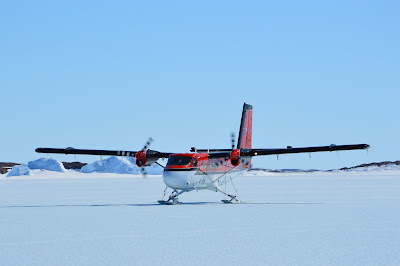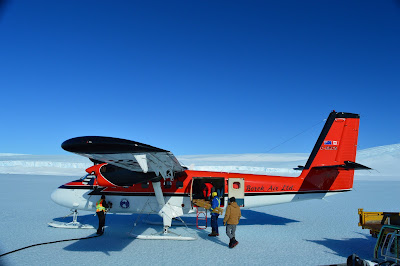 |
| The chicks have grown a lot! |
I had been trying to find the time to get back to Macey Island to finish a gas job on one of the huts, and I had virtually lost hope that it was going to happen when our Station Leader (SL) approached me and asked if I would lead a trip to the rookery for a day. Previously this year the role of trip leader to Macey and Auster has been reserved for returning expeditioners (with previous seasons experience) and the SL (a first timer, with no experience) due to the perceived added risk of sea ice travel. This has been a bit of a sore point with one or two people on station, so I felt privileged to be offered the responsibility. I should point out that I, along with nearly everyone else qualified early on in our season as a trip leader for travel on the plateau, and I consider that a place of higher danger due to crevasses and much less stable weather (you can see why some were "confused" by the SL's stance on trip leaders for Auster/Macey... however, those were the rules).
The plan was to go on Thursday, but weather conspired against us with high winds and cloud, so the decision was made to try again on Friday. Friday morning arrived with a much better outlook and at 8am we were on our way. My crew consisted of Tony, our new comms tech and fellow Kiwi; Kevin our new sparky, and James our young summer plumber. We made good time to Macey after detouring around a large patch of open water that previously was part of our marked GPS route. In two hours we were at the hut with tools in hand, James and I replacing the gas regulator and pipe work on the "Apple", Kevin replacing a some electrical componentry in the main hut, and Tony just having a good look around, in the process discovering that the party that had overnighted on Thursday had left behind their sat phone. Well spotted Tony!
 |
| James, getting up close and personal with my friends. |
 |
| So trusting, within touching distance. |
We arrived at the "car park" in no time and were greeted by Big Pete who'd walked back to their Hagg to sched in with VLV Mawson. The colony had moved a couple of kilometres since I was last there and Pete pointed us in the right direction. Soon we found the emperors and my crew were surrounded by them in no time. The day was calm and warm, conditions that seem to encourage the birds to come out and be sociable. We couldn't have asked for more given that for two of my crew this will likely have been a once in a lifetime experience (Tony is here for a summer-winter-summer contract so will have more opportunities next winter). From my perspective I was overjoyed that my last visit was probably my most enjoyable.
Unfortunately our time was up all too soon, and we began the long walk back to the Haggs, and then started the long journey home. We planned to stop at Paterson Island to visit the Weddel seal pups so had to allow time for that. I found myself taking long looks at the icy scenery and the penguins as I walked away. As my year here progresses and draws to an end I find myself questioning whether I will return. If I do apply to come back the likelihood of returning to Mawson is unlikely, so I very much doubt if I will ever see these beautiful birds in the wild again like I have this year. Other stations have emperors pass through now and then but nothing like we have here.
 |
| Most of the chicks are keen to interact now. |
On the return journey we stopped at Macklyn Island near some suspicious grey ice and drilled down to see how thick it was. Sea ice at it's peak is normally 1.6-2m thick. Our first drill right beside our track measured just .5m, then a few paces away a scary .15m! The minimum required before Hagg travel is allowed at the beginning of winter is .8m..... Pete's exact words after drilling a third time was "lets get the **** away from here!" It surprised me just how obvious the thinner ice was, not at all the blue we are used to but a sickly, rotten looking grey.
 |
| Two of those puppy dog eyes..... |
Fortunately from this point on back to station the ice all looked healthy and our stop at Paterson was our only interruption. The seal pups had grown an unbelievable amount in the four weeks since I last saw them, and they are all swimming and losing the furry coats they were born in. They still have their beautiful puppy dog eyes though, and are not at all bothered by a group of humans with cameras. We wasted no time here, as some ominous looking cloud was quickly closing in on us from the east. Within an hour of arriving back on station surface definition had reduced greatly, and shortly after this it started snowing.
That is the end of the emperors for me. I didn't feel the sadness that I thought I would when leaving them for the last time. Having visited six times I think I've had my fill of them for a while. If by some chance I do return to Mawson one day, I know I will look forward to the experience again, but having had the opportunities that most people only see in a documentary, I can feel nothing but privileged.
Thank you beautiful Emperor penguins. I will always remember your gentleness with each other, and incredible curiosity and eagerness to share our company. I will miss all of you.
 |
| Despite living in such close proximity to each other, I've only ever seen displays of tolerance and affection from these beautiful, gentle creatures. |





